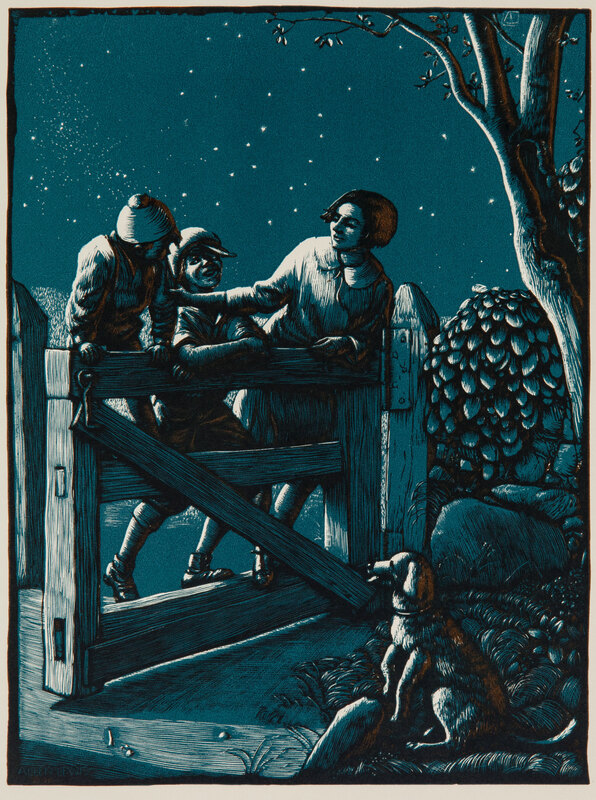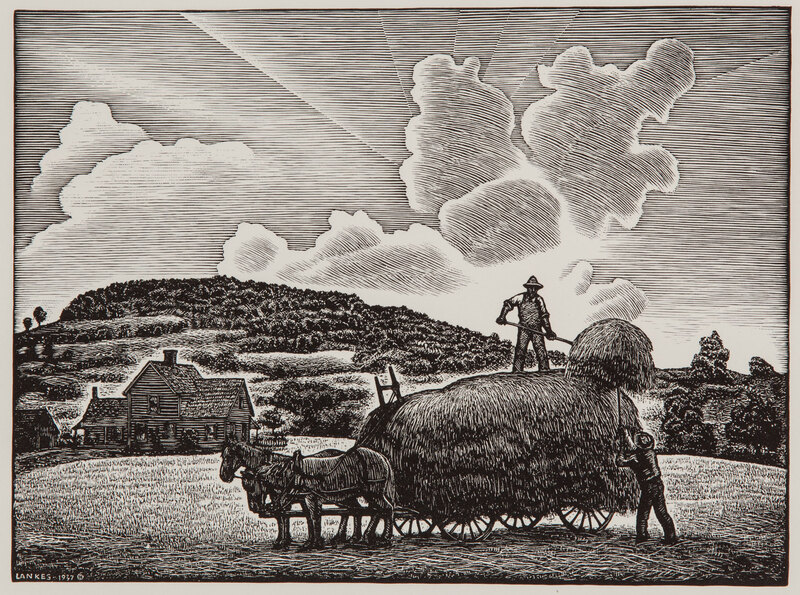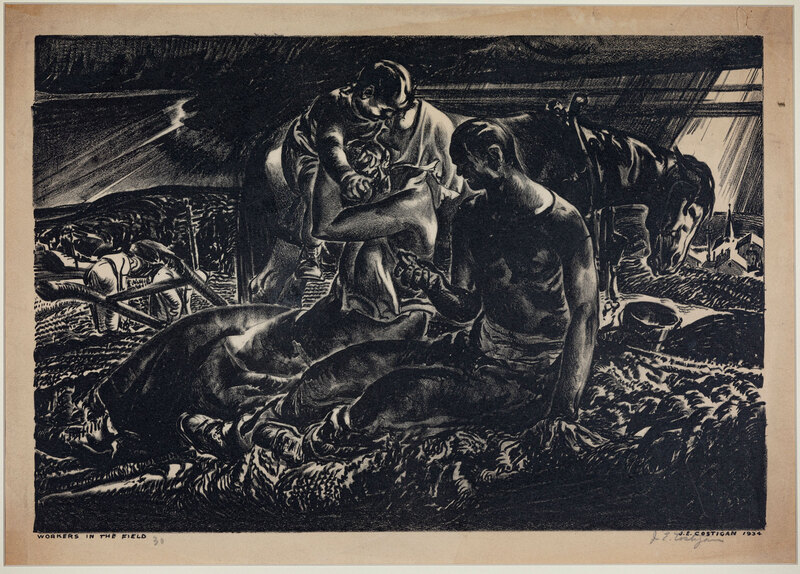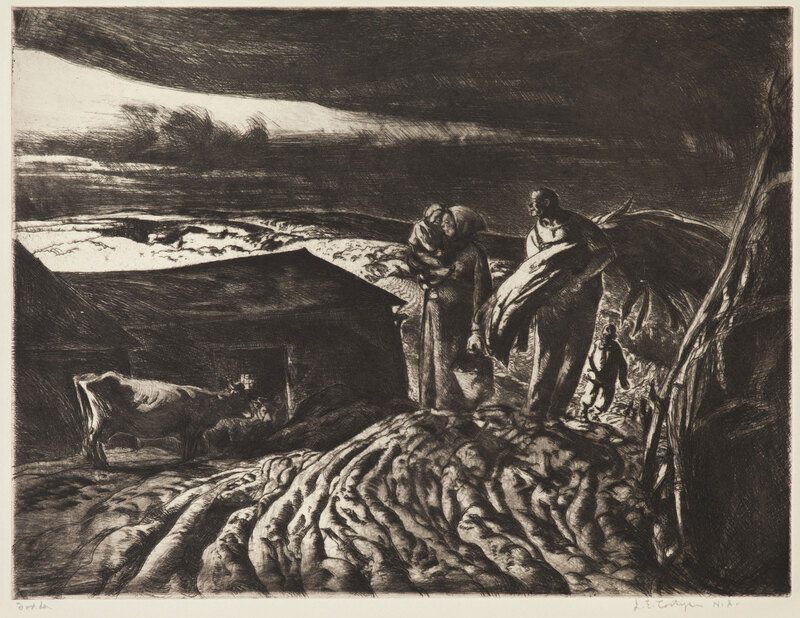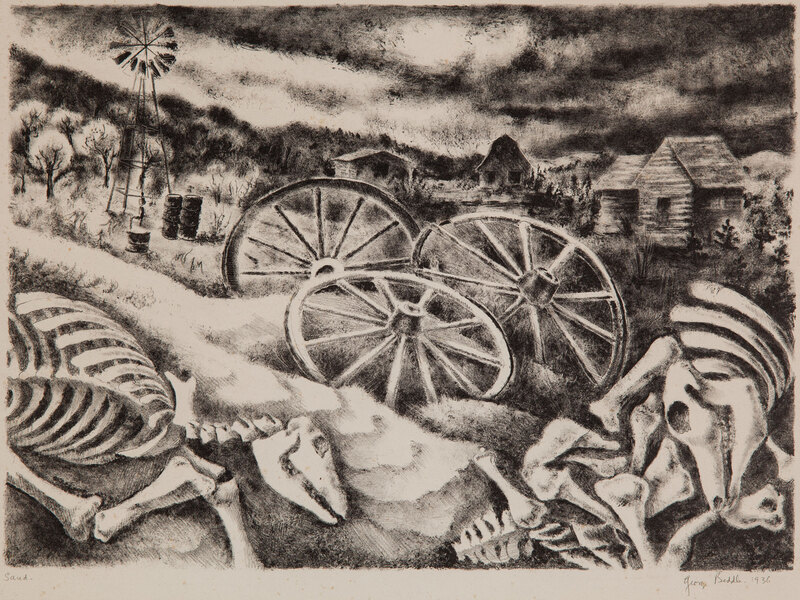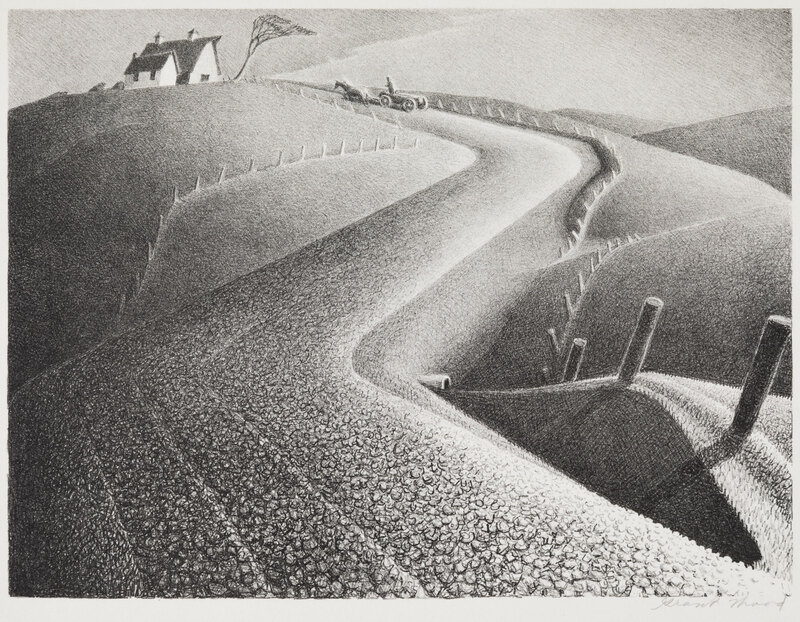Rural Life and Labor
Identifying America as a “frontier” or “heartland” continued long passed the time it had become increasingly urban. Whereas urban images emphasized technology and workers collectively, rural pictures emphasized the dauntless farmer working the land, despite the drought, Dust Bowl and other forms of devastation.
Already by 1920, more Americans were living in cities than in rural areas—an epochal shift in the demographic distribution of the population—but, in the national imagination, it was still the “heartland,” a fantasy of wide stretches of farmland and prairie inhabited by independent yeoman farmers, that defined the American character. In the late nineteenth century, historian Frederick Jackson Turner (American, 1861 – 1932) had spoken in triumphal terms of “the significance of the frontier in American history,” seeing the country’s expansion into the “empty” spaces of the West as the very crucible of our national spirit, fostering those qualities of self-reliance and ruggedness that distinguished the “New” World from the “Old.” That such a story erased the indigenous populations of the continent, ignored the role of enslaved peoples in building the nation and excluded the growing numbers of immigrants from southern and eastern Europe who were settling in the big cities tells us just how blinkered this dominant, Anglo-Saxon understanding of American history was. Its hold on the minds of many, however, remained strong.
In the 1930s, celebrations in art of rural life and labor served as something of a compensatory fantasy. Even as the growing mechanization of agriculture made the family farm increasingly obsolete—the Dust Bowl ravaged much of the nation’s arable land and farm foreclosures mounted during the Depression—“American Scene” artists produced visions of a rich, fertile countryside and of hardworking farmers taming the land. Of course, the nation’s farmers did work hard, but a comparison with contemporary images of industrial labor is telling: urban work tended to be shown as performed by members of a class, in other words as collective and cooperative, whereas farm work was shown as, if not strictly individualized, undertaken at most within the family; images of industry took pride in advanced technology, fusing workers and their machines, whereas images of farming tended to depict the use of simpler tools and to show the farmer dominating the land.
Of course, there were countervailing tendencies. The toll of ecological and personal devastation exacted by the Dust Bowl could not simply be ignored, and artists produced an extensive iconography—the images or symbols that illustrate a subject—of drought: blanched, dry landscapes denuded of vegetation; abandoned farmhouses left to decay; bleached bones of cattle half-buried in the depleted soil. What were such pictures of ruin meant to convey? Unlike documentary photographs, they were imagined scenes and at some level the viewer was asked to find pleasure in them. They became something like contemporary American equivalents to those images of the lost glories of Greece and Rome, a testament at once nostalgic and dreadful to the vanity of human ambition.
––TMD
Thomas Hart Benton (American, 1889 – 1975)
Cradling Wheat, 1928
Graphite, pen, wash and crayon; 11 ½ x 17 ½”
Binghamton University Art Museum, 1969.15
It is no exaggeration to call Thomas Hart Benton the exemplary artist of “American Scene” painting. Although he had embraced modernism earlier in his career, by the 1920s Benton had become a champion of Regionalism, which sought to root American art in the nation’s distinctive landscapes and people, rejecting outside influences from Europe. In Summer 1928, he drove across the South with a friend, traveling from Pittsburgh to Georgia and Louisiana all the way to New Mexico, making sketches of the people and countryside he found along the way. Cradling Wheat was a product of that trip, a scene in east Tennessee of three men and a boy cutting—“cradling”—wheat and tying it in bunches. The rolling hills of the Appalachian Mountains, along with some trees and a farmhouse, can be seen behind them. Six years later, Benton would transform this sketch into a painting, owned by the Saint Louis Art Museum.
––TMD
Allen Lewis (American, 1873 – 1957)
Swinging the Gate, 1936
color woodcut; 18 x 13”
Binghamton University Art Museum, 2016.4.378
gift of Gil and Deborah Williams
Interpretive text has not been prepared for this object.
J. J. Lankes (American, 1884 – 1960)
Haying No. 1, 1937
wood engraving; 13 x 18”
Binghamton University Art Museum, 2016.4.375
gift of Gil and Deborah Williams
Interpretive text has not been prepared for this object.
John E. Costigan (American, 1888 – 1972)
Workers of the Soil, 1932
etching; 12 x 16”
Roberson Museum and Science Center, 1984R39
On a hill overlooking a modest farmhouse, a woman sits nursing her infant as another child kneels reverently before her. Her husband, standing alongside them, takes a long drink from a water jug. His horse and plow wait behind the group, as barren hills stretch out beyond. The slight bowing of the horizon line suggests the curvature of the Earth, as if this simple scene in the American Midwest embraced the whole world. The dramatic light that descends upon this family from a lowering sky only amplifies that sense of portentous religiosity, and there is here a strong suggestion of the traditional Christian theme of the rest on the flight into Egypt. The monumentality of the figures—their massiveness against the distant landscape—also recalls the precedent of nineteenth-century French painter Jean-François Millet, who lent his peasant farmers a dignified, timeless quality.
––TMD
John E. Costigan (American, 1888 – 1972)
Fodder, 1935
etching; 12 ½ x 15 ¾”
Binghamton University Art Museum, 2016.4.90
gift of Gil and Deborah Williams
Interpretive text has not been prepared for this object.
George Biddle (American, 1885 – 1973)
Sand!, 1936
lithograph; 13 x 17 ¾”
Binghamton University Art Museum, 2016.4.408
gift of Gil and Deborah Williams
Interpretive text has not been prepared for this object.
Grant Wood (American, 1892 – 1942)
March, 1939, published 1941
lithograph; 11 x 13 ¾”
Binghamton University Art Museum, 2019.17.2
purchase with funds from Lucie G. Nelson ’77 PhD
Grant Wood here imagines a blustery spring day in the Midwest, in the rolling hills of eastern Iowa that were long his home. A stylized dirt road zigzags through the center of the print into the distance, terminating in a farm and a lone tree that both seem to lean with the strong wind blowing across the landscape; in the middle ground, a farmer in his horse-drawn cart similarly struggles against the gale as he approaches his destination. From this forbidding desolation, verdant fields will soon emerge.
Along with Thomas Hart Benton, Wood was one of the most recognized of the Regionalists, best known for his 1930 painting American Gothic, which became an overnight classic. By 1939, he was teaching at the University of Iowa and had directed that state’s Public Works of Art Project. March is one of eighteen lithographs Wood made for the Associated American Artists between 1937 and 1941.
––TMD

